Building Adaptive Capacity in Changing Social-Ecological Systems: Integrating Knowledge in Communal Land-Use Planning in the Peruvian Amazon
Abstract
1. Introduction
2. Methodological Approach
2.1. Theoretical Framework for Assessing Adaptive Capacity
2.2. The Social-Ecological System: The Shamboyacu Sector in the Buffer Zone of Cordillera Azul National Park
2.3. Material and Methods
Selecting case study and interviewees
Analysing the interviews
Analysing forest cover changes
3. Results
3.1 Social Capital
3.1.1 Building Trust among Stakeholders
The people realized that we were not a project that lasts two or three years and is only going to achieve one target […]. By contrast, our objective for all of our life is conservation and to integrate productive activities and our best allies here are the rural communities, the club of mothers, the committees of producers and others, with whom we have to work.(Technical staff CIMA)
We observe that they themselves become aware of their communal reality and their responsibility [for their lands]. They realize that we do not bring schools, bridges, or other things to hand over. The work we do is training, raising awareness, support for management processes and technical advice on production.(Technical staff CIMA)
The NGO has helped us, because we are proud of conserving our forest without any reward.(Community member Lejía)
3.1.2. Collaboration in the ZPC Process
What I understand (from the ZPC map) is that it indicates where we have to saw trees where they have been lost.
Today, the population acknowledges more the work we are doing, because all of the information we jointly generated, does already serve them. We always told them what was good for what and now it actually does serve for what it was meant for and that is the advantage.(Technical staff CIMA)
3.2. Learning Capacities
3.2.1. Developing Institutions of Knowledge
3.2.2. Building Learning Capacities
3.3. Governance
There are no conflicts on community boundaries, not with Vista Alegre nor with Simón Bolívar. And not within the community either.
3.3.1. Rules
For example in our communal forest. In our assembly we have said that those are the limits and beyond those nobody is to enter here. If there are news that somebody has entered, we form a committee to verify trails and how it is. And that is how it ends. But until today were did not have to enforce this law.
We also have our areas for conservation like those we have up on the hillside - a real quantity! The first people that came here [said], ‘we will not chop down until there is no more.’ They cut down an area and [said] ‘here we are going to work’ […] Based on this we developed some records that every person has to conserve the environment, [for example] in slopes and around water sources.(Community member Lejía)
3.3.2. Participation
3.3.3. Generating Leadership in Conservation Activities
We are going to protect the environment and the water, because in time it will be gone
3.4. Adaptive Management
3.4.1. Risk Perception
Throughout the ZPC we produce a historic timeline collecting information for the period of the last 20 years, describing floods, natural disasters, storms and all types of natural disasters that pose risks for the population.(CIMA technical staff)
3.4.2. Adapted Practices
This part up here is not to be touched. [indicating the communal reserve]. We leave the water fountains [as they are].” “Mountain slopes are respected. We are an organized village. Everybody understands that it is not allowed to touch certain parts.(Community member Paraíso)
3.5. Short Term Conservation Outcomes
4. Discussion
4.1. Adaptive Capacity Depends on Effective Knowledge Integration
4.2. Land Use Planning for Local Sustainable SES—Potential and Limitations of the ZPC Process
4.3. Limitations of Research Approach and Outlook
5. Conclusions
Acknowledgments
Author Contributions
Conflicts of Interest
Appendix A. The FOCAL Approach Developed by CIMA
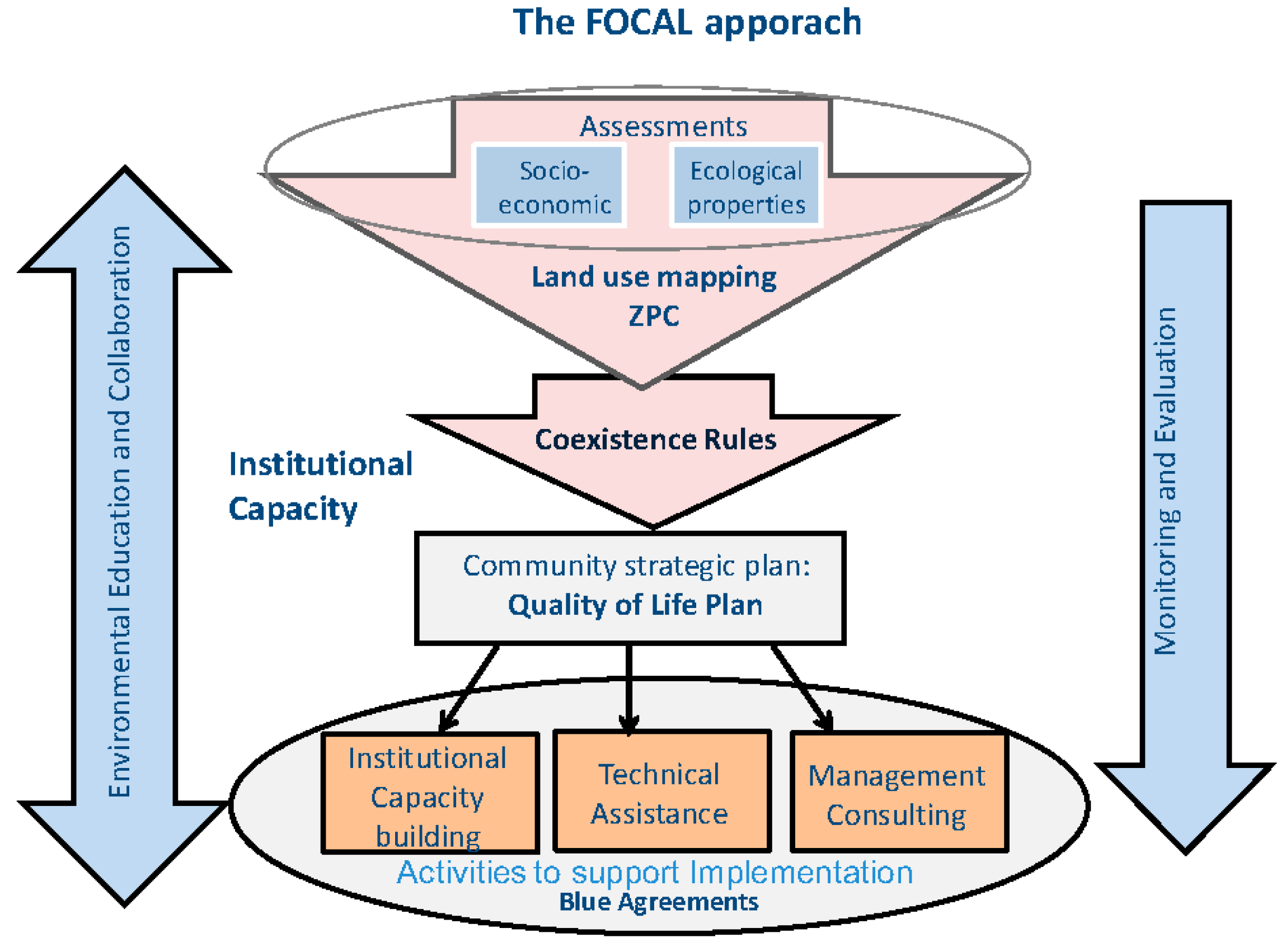
Appendix B. Supplementary Information on ZPC Process
Appendix B.1. Regulatory Context for ZPC (as Implemented by CIMA)
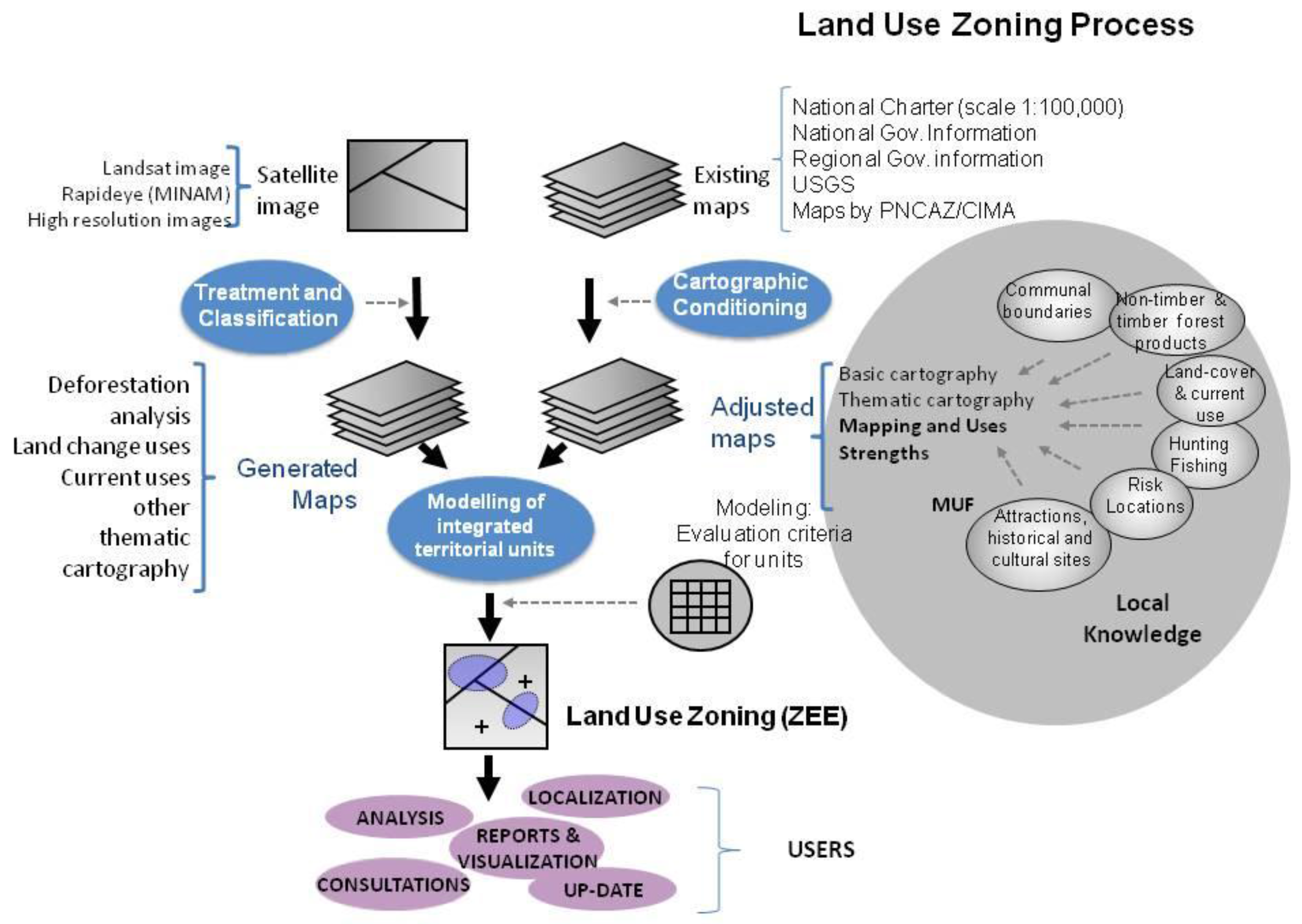
Appendix B.2. Description of the ZPC
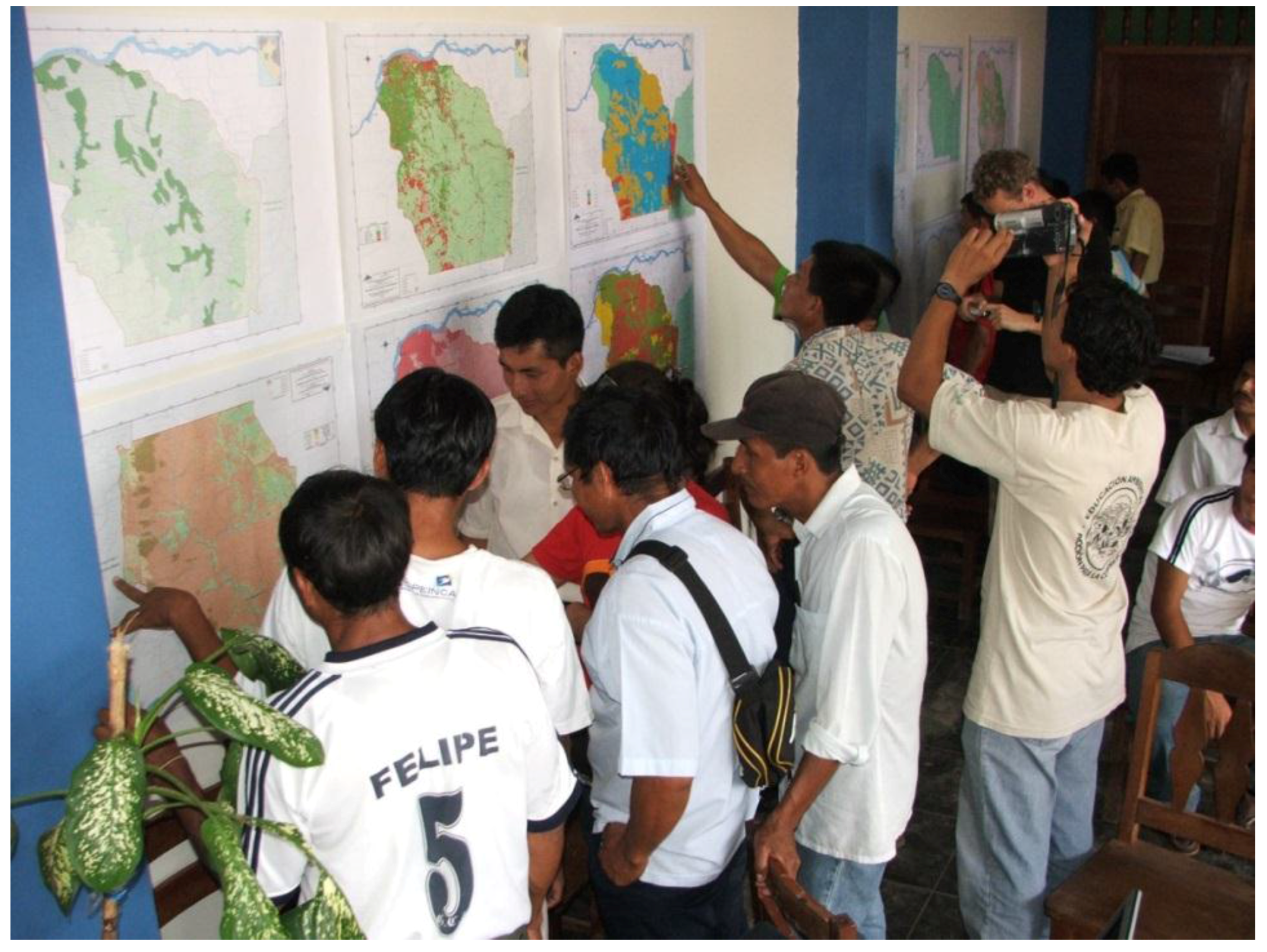
| Higher Categories | Ecological-Economic Zones | Recommended Uses | Type of Vegetation (*) | % |
|---|---|---|---|---|
| Production | Annual/mono-culture crops | 1 | T | 0.00 |
| Permanent crops | 2,3,4,5,6,7,8,12,13,14,15,16,17 | T | 4.15 | |
| Forestry | 4,5,6,7,12,14,15,16 y 17 | N | 43.70 | |
| Protection & Conservation | Protection zones | 12,14,15 y 17 | N | 11.07 |
| Conservation zones | 12,14,15 y 17 | N | 4.63 | |
| Restoration | For protection and conservation | 12,14,15 y 17 | T | 4.50 |
| For forestry production | 4,5,6,12,14,15,17 | T | 31.50 | |
| Urban | Human settlements | 12,14,15,17,18 | T | 0.47 |
Appendix C. Technical Details on Deforestation Analysis
References
- Phillips, O.L.; Aragão, L.E.; Lewis, S.L.; Fisher, J.B.; Lloyd, J.; López-González, G.; Malhi, Y.; Monteagudo, A.; Peacock, J.; Quesada, C.A.; et al. Drought sensitivity of the Amazon rainforest. Science 2009, 323, 1344–1347. [Google Scholar] [CrossRef] [PubMed]
- Oliveira, P.J.; Asner, G.P.; Knapp, D.E.; Almeyda, A.; Galván-Gildemeister, R.; Keene, S.; Raybin, R.F.; Smith, R.S. Lan-Use Allocation Protects the Peruvian Amazon. Science 2007, 317, 1233–1236. [Google Scholar] [CrossRef] [PubMed]
- Zinngrebe, Y. Learning from local knowledge in Peru—Ideas for more effective biodiversity conservation. J. Nat. Conserv. 2016, 32, 10–21. [Google Scholar] [CrossRef]
- Berkes, F.; Folke, C. (Eds.) Linking Social and Ecological Systems: Management Practices and Social Mechanisms for Building Resilience; Cambridge University Press: Cambridge, UK, 1998. [Google Scholar]
- Ostrom, E.A. General framework for analyzing sustainability of social-ecological systems. Science 2009, 325, 419–422. [Google Scholar] [CrossRef] [PubMed]
- Walker, B.; Holling, C.S.; Carpenter, S.R.; Kinzig, A. Resilience, adaptability and transformability in social–ecological systems. Ecol. Soc. 2004, 9, 5. [Google Scholar] [CrossRef]
- Folke, C.; Hahn, T.; Olsson, P.; Norberg, J. Adaptive Governance of Social-Ecological Systems. Annu. Rev. Environ. Resour. 2005, 30, 441–473. [Google Scholar] [CrossRef]
- Walker, B.; Carpenter, S.; Anderies, J.; Abel, N.; Cumming, G.; Janssen, M.; Lebel, L.; Norberg, J.; Peterson, G.; Pritchard, R. Resilience Management in Socio-ecological Systems: A Working Hypothesis for a participatory approach. Conserv. Ecol. 2002, 6, 14. [Google Scholar] [CrossRef]
- Davidson-Hunt, I.; Berkes, F. Learning as you journey: Anishinaabe perception of social-ecological environments and adaptive learning. Conserv. Ecol. 2003, 8, 5. [Google Scholar] [CrossRef]
- Chapin, F.S. Managing Ecosystems Sustainability: The Key Role of Resilience. In Principles of Ecosystem Stewardship; Folke, C., Kofinas, G.P., Chapin, F.S., Eds.; Springer: New York, NY, USA, 2009. [Google Scholar]
- Van Vleet, E.; Bray, D.B.; Durán, E. Knowing but not knowing: Systematic conservation planning and community conservation in the Sierra Norte of Oaxaca, Mexico. Land Use Policy 2016, 59, 504–515. [Google Scholar] [CrossRef]
- Davidson-Hunt, I. Adaptive learning networks: Developing resource management knowledge through social learning forums. Hum. Ecol. 2006, 34, 593–614. [Google Scholar] [CrossRef]
- Boillat, S.; Berkes, F. Perception and interpretation of climate change among Quechua farmers of Bolivia: Indigenous knowledge as a resource for adaptive capacity. Ecol. Soc. 2013, 18, 21. [Google Scholar] [CrossRef]
- Bohensky, E.; Maru, Y. Indigenous Knowledge, Science, and Resilience: What have we learned from a decade of international literature on “integration”? Ecol. Soc. 2011, 16, 6. [Google Scholar] [CrossRef]
- Hughes, R.; Flintan, F. Integrating Conservation and Development Experience: A Review and Bibliography of the ICDP Literature; International Institute for Environment and Development: London, UK, 2001. [Google Scholar]
- Bauch, S.C.; Sills, E.O.; Pattanayak, S.K. Have we managed to integrate conservation and development? ICDP impacts in the Brazilian Amazon. World Dev. 2014, 64, S135–S148. [Google Scholar] [CrossRef]
- Brooks, J.S.; Franzen, M.A.; Holmes, C.M.; Grote, M.N.; Mulder, M.B. Testing hypotheses for the success of different conservation strategies. Conserv. Boil. 2006, 20, 1528–1538. [Google Scholar] [CrossRef] [PubMed]
- Ozor, N.; Cynthia, N. The role of extension in agricultural adaptation to climate change in Enugu State, Nigeria. J. Agric. Ext. Rural Dev. 2011, 3, 42–50. [Google Scholar]
- CIMA. FOCAL: Modelo Para el Fortalecimiento de Capacidades Locales para la Gestión del Territorio y la Mejora de la Calidad de Vida; Centro de Conservación, Investigación y Manejo de Áreas Naturales (CIMA)—Cordillera Azul: Lima, Peru, 2013. [Google Scholar]
- CIMA. Guía MUF. Mapeo de 5 Usos y Fortalezas; Centro de Conservación, Investigación y Manejo de Áreas Naturales (CIMA)—Cordillera Azul: Lima, Peru, 2014. [Google Scholar]
- GIZ. Land-use Planning in Peru: Connecting People and Resources. In Land-Use Planning: Concepts, Tools and Applications; Annex A3; GIZ/BMZ: Berlin, Germnay, 2012; pp. 240–246. [Google Scholar]
- Walker, B.; Gunderson, L.H.; Kinzig, A.P.; Folke, C.; Carpenter, S.R.; Schultz, L. A handful of heuristics and some propositions for understanding resilience in social-ecological systems. Ecol. Soc. 2006, 11, 13. [Google Scholar] [CrossRef]
- Gallopin, G.C. Linkages between vulnerability, resilience, and adaptive capacity. Glob. Environ. Chang. 2006, 16, 293–303. [Google Scholar] [CrossRef]
- Engle, N.E. Adaptive capacity and its assessment. Glob. Environ. Chang. 2011, 21, 647–656. [Google Scholar] [CrossRef]
- Carpenter, S.R.; Walker, B.; Anderies, M.J.; Abel, N. From metaphor to measurement: Resilience of what to what? Ecosystems 2001, 4, 765–781. [Google Scholar] [CrossRef]
- Adger, W.N. Vulnerability. Glob. Environ. Chang. 2006, 16, 268–281. [Google Scholar] [CrossRef]
- Cote, M.; Nightingale, A. Resilience thinking meets social theory: Situating social change in socio-ecological systems (SES) research. Prog. Hum. Geogr. 2012, 36, 475–489. [Google Scholar] [CrossRef]
- Tengö, M.; Brondizio, E.; Elmqvist, T.; Malmer, P.; Spierenburg, M. Connecting Diverse Knowledge Systems for Enhanced Ecosystem Governance: The Multiple Evidence Base Approach. AMBIO 2014, 43, 579–591. [Google Scholar] [CrossRef] [PubMed]
- Pahl-Wostl, C. A conceptual framework for analysing adaptive capacity and multi-levellearning processes in resource governance regimes. Glob. Environ. Chang. 2009, 19, 354–365. [Google Scholar] [CrossRef]
- Moller, H.; Berkes, F.; Lyver, P.; Kisalioglu, M. Combining Science and Traditional Ecological Knowledge: Monitoring Populations for Co-Management. Ecol. Soc. 2004, 9, 2. [Google Scholar] [CrossRef]
- Bohensky, E.; Butler, J.; Davies, J. Integrating indigenous ecological knowledge and science in natural resource management: Perspectives from Australia. Ecol. Soc. 2013, 18, 20. [Google Scholar] [CrossRef]
- Lockwood, M.; Raymond, C.M.; Oczkowski, E.; Morrison, M. Measuring the dimensions of adaptive capacity: A psychometric approach. Ecol. Soc. 2015, 20, 37. [Google Scholar] [CrossRef]
- Pretty, J. Social capital and the collective management of resources. Science 2003, 302, 1912–1915. [Google Scholar] [CrossRef] [PubMed]
- Pretty, J.; Smith, D. Social capital in biodiversity conservation and management. Conserv. Biol. 2004, 18, 631–638. [Google Scholar] [CrossRef]
- Ostrom, E. Revising theory in light of experimental findings. J. Econ. Behav. Organ. 2010, 73, 68–72. [Google Scholar] [CrossRef]
- Yates, J.S. Uneven Interventions and the scalar politics of governing livelihood adaptation in rural Nepal. Glob. Environ. Chang. 2012, 22, 537–546. [Google Scholar] [CrossRef]
- Berkes, F. Evolution of co-management: Role of knowledge generation, bridging organizations and social learning. J. Environ. Manag. 2009, 90, 1692–1702. [Google Scholar] [CrossRef] [PubMed]
- Gupta, J.; Termeer, C.; Klostermann, J.; Meijerink, S.; van den Brink, M.; Jong, P.; Nooteboom, S.; Bergsma, E. The adaptive capacity wheel: A method to assess the inherent characteristics of institutions to enable the adaptive capacity of society. Environ. Sci. Policy 2010, 13, 459–471. [Google Scholar] [CrossRef]
- Dietz, T.; Ostrom, E.; Stern, P.C. The struggle to govern the commons. Science 2003, 302, 1907–1912. [Google Scholar] [CrossRef] [PubMed]
- Schutz, L.; Folke, C.; Österblom, H.; Olsson, P. Adaptive governance, ecosystem management, and natural capital. Proc. Natl. Acad. Sci. USA 2015, 112, 7369–7374. [Google Scholar] [CrossRef] [PubMed]
- Méndez-López, M.E.; García-Frapolli, E.; Pritchard, D.J.; González, M.C.S.; Ruiz-Mallén, I.; Porter-Bolland, L.; Reyes-Garcia, V. Local participation in biodiversity conservation initiatives: A comparative analysis of different models in South East Mexico. J. Environ. Manag. 2014, 145, 321–329. [Google Scholar] [CrossRef] [PubMed]
- Plummer, R.; Armitage, D. Integrating perspectives on adaptive capacity and environmental governance. In Adaptive Capacity and Environmental Governance; Springer: Berlin/Heidelberg, Germany, 2010; pp. 1–19. [Google Scholar]
- Holling, C.S. Resilience and stability of ecological systems. Annu. Rev. Ecol. Syst. 1973, 4, 1–23. [Google Scholar] [CrossRef]
- Rist, L.; Felton, A.; Samuelsson, L.; Sandström, C.; Rosvall, O. A new paradigm for adaptive management. Ecol. Soc. 2013, 18, 63. [Google Scholar] [CrossRef]
- Christensen, N.L.; Bartuska, A.M.; Brown, J.H.; Carpenter, S.; D’Antonio, C.; Francis, R.; Franklin, J.F.; MacMahon, J.A.; Noss, R.F.; Parsons, D.J.; et al. The report of the Ecological Society of America committee on the scientific basis for ecosystem management. Ecol. Appl. 1996, 6, 665–691. [Google Scholar] [CrossRef]
- Linares-Palomino, R.; Oliveira-Filho, A.T.; Pennington, R.T. Neotropical seasonally dry forests: Diversity, endemism, and biogeography of woody plants. In Seasonally Dry Tropical Forests: Ecology and Conservation; Dirzo, R., Mooney, H., Ceballos, G., Young, H., Eds.; Island Press/Center for Resource Economics: Washington, DC, USA, 2011; pp. 3–21. [Google Scholar]
- SERNANP. Parque Nacional Cordillera Azul. Diagnóstico del proceso de actualización del Plan Maestro; Servicio Nacional de Áreas Naturales Protegidas por el Estado (SERNANP): Lima, Peru, 2012. [Google Scholar]
- Holland, T.G.; Coomes, O.T.; Robinson, B.E. Evolving frontier land markets and the opportunity cost of sparing forests in western Amazonia. Land Use Policy 2016, 58, 456–471. [Google Scholar] [CrossRef]
- Gavin, M.C.; Anderson, G.J. Socio-economic predictors of forest use values in the Peruvian Amazon: A potential tool for biodiversity conservation. Ecol. Econ. 2007, 60, 752–762. [Google Scholar] [CrossRef]
- Mayer, E. The Articulated Peasant: Household Economies in the Andes; Westview Press: Boulder, CO, USA, 2001. [Google Scholar]
- Gitlitz, J.; Rojas, T. Peasant Vigilant Committees in Northern Peru. J. Latin Am. Stud. 1983, 15, 163–197. [Google Scholar] [CrossRef]
- Nuñez Palomino, G. The rise of the Rondas Campesinas in Peru. J. Legal Plur. Unoff. Law 1996, 28, 111–123. [Google Scholar] [CrossRef]
- Mayring, P. Qualitative Content Analysis: Theoretical Foundation, Basic Procedures and Software Solution; Leipniz-Institut for Social Science: Klagenfurt, Austria, 2014. [Google Scholar]
- Glaser, B.G.; Strauss, A.L. The Discovery of Grounded Theory. Strategies for Qualitative Research; Routledge: Piscataway, NJ, USA, 2012. [Google Scholar]
- Hansen, M.C.; Potapov, P.V.; Moore, R.; Hancher, M.; Turubanova, S.; Tyukavina, A.; Thau, D.; Stehman, S.V.; Goetz, S.J.; Loveland, T.R.; et al. High-resolution global maps of 21st-century forest cover change. Science 2013, 342, 850–853. [Google Scholar] [CrossRef] [PubMed]
- Potapov, P.V.; Dempewolf, J.; Talero, Y.; Hansen, M.C.; Stehman, S.V.; Vargas, C.; Rojas, E.J.; Castillo, D.; Mendoza, E.; Calderón, A.; et al. National satellite-based humid tropical forest change assessment in Peru in support of REDD+ implementation. Environ. Res. Lett. 2014, 9, 124012. [Google Scholar] [CrossRef]
- Nelson, A.; Chomitz, K.M. Effectiveness of strict vs. multiple use protected areas in reducing tropical forest fires: A global analysis using matching methods. PLoS ONE 2011, 6, E22722. [Google Scholar] [CrossRef] [PubMed]
- Walker, W.; Baccini, A.; Schwartzman, S.; Ríos, S.; Oliveira-Miranda, M.A.; Augusto, C.; Romero Ruiz, M.; Soria Arrasco, S.; Ricardo, B.; Smith, R.; et al. Forest carbon in Amazonia: The unrecognized contribution of indigenous territories and protected natural areas. Carbon Manag. 2014, 5, 479–485. [Google Scholar] [CrossRef]
- Nolte, C.; Agrawal, A.; Silvius, K.M.; Soares-Filho, B.S. Governance regime and location influence avoided deforestation success of protected areas in the Brazilian Amazon. Proc. Natl. Acad. Sci. USA 2013, 110, 4956–4961. [Google Scholar] [CrossRef] [PubMed]
- Gockel, C.; Gray, L.C. Integrating conservation and development in the Peruvian Amazon. Ecol. Soc. 2009, 14, 11. [Google Scholar] [CrossRef]
- Huggel, C.; Scheel, M.; Albrecht, F.; Andres, N.; Calanca, P.; Jurt, C.; Khabarov, N.; Mira-Salama, D.; Rohrer, M.; Salzmann, N. A framework for the science contribution in climate adaptation: Experiences from science-policy processes in the Andes. Environ. Sci. Policy 2015, 47, 80–94. [Google Scholar] [CrossRef]
- Bieling, C.; Plieninger, T. (Eds.) Resilience and the Cultural Landscape: Understanding and Managing Change in Human-Shaped Environments; Cambridge University Press: Cambridge, UK, 2012. [Google Scholar]
- Schleyer, C.; Lux, A.; Mehring, M.; Görg, C. Ecosystem services as a boundary concept: Arguments from social ecology. Sustainability 2017, 9, 1107. [Google Scholar] [CrossRef]
- Mercer, J.; Kelman, I.; Lloyd, K.; Suchet-Pearson, S. Participatory research for disaster reduction. Area 2008, 40, 172–183. [Google Scholar] [CrossRef]
- Linstädter, A.; Kuhn, A.; Naumann, C.; Rasch, S.; Sandhage-Hofmann, A.; Amelung, W.; Jordaan, J.; Du Preez, C.; Bollig, M. Assessing the resilience of a real-world social-ecological system: Lessons from a multidisciplinary evaluation of a South African pastoral system. Ecology and Society 2016, 21, 35. [Google Scholar] [CrossRef]
- Lasage, R.; Muis, S.; Sardella, C.S.E.; van Drunen, M.A.; Verburg, P.H.; Aerts, J.C.J.H. Vulnerability to climate change and community based adaptation in the Peruvian Andes, a stepwise approach. Sustainability 2015, 7, 1742–1773. [Google Scholar] [CrossRef]
- Montoya, M.; Young, K.R. Sustainability of natural resource use for an Amazonian indigenous group. Reg. Environ. Chang. 2013, 13, 1273–1286. [Google Scholar] [CrossRef]
- Marquardt, K.; Salomonsson, L.; Geber, U. Farmers facing rapid agricultural land condition changes in two villages in the Upper Amazon, Peru: Can action learning contribute to resilience? Int. J. Agric. Resour. Gov. Ecol. 2009, 8, 457–483. [Google Scholar] [CrossRef]
- Pequeño, S.T.; Fernandez-Dávila, M.P. Parque Nacional Cordillera Azul: Construyendo un Modelo de Gestión Integral en Áreas Protegidas. In En: Planificación y Gestión de Áreas Protegidas en América del Sur: Avances en la Aplicación del Enfoque Ecosistémico; Casavecchia, C., Lobo Peredo, A., Arguedas Mora, S., Eds.; UICN: Quito, Ecuador, 2014. [Google Scholar]
- Nepstad, D.; McGrath, D.; Stickler, C.; Alencar, A.; Azevedo, A.; Swette, B.; Bezerra1, T.; DiGiano, M.; Shimada, J.; Seroa da Motta, R.; et al. Slowing Amazon deforestation through public policy and interventions in beef and soy supply chains. Science 2014, 344, 1118–1123. [Google Scholar] [CrossRef] [PubMed]
- Carrasco, L.R.; Webb, E.L.; Symes, W.S.; Koh, L.P.; Sodhi, N.S. Global economic trade-offs between wild nature and tropical agriculture. PLoS Boil. 2017, 15, e2001657. [Google Scholar] [CrossRef] [PubMed]
- Nolte, C.; de Waroux, Y.L.P.; Munger, J.; Reis, T.N.; Lambin, E.F. Conditions influencing the adoption of effective anti-deforestation policies in South America’s commodity frontiers. Glob. Environ. Chang. 2017, 43, 1–14. [Google Scholar] [CrossRef]
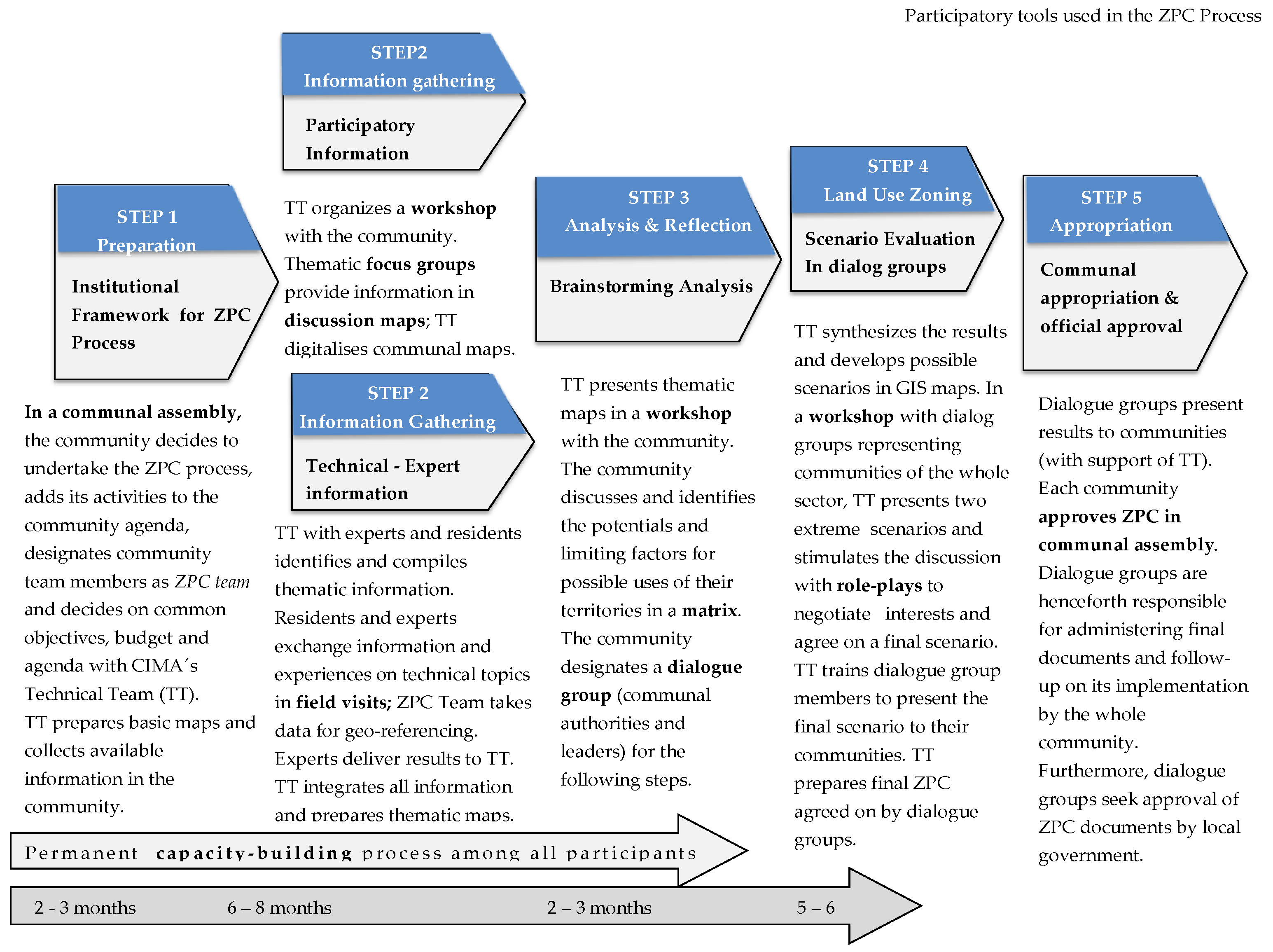
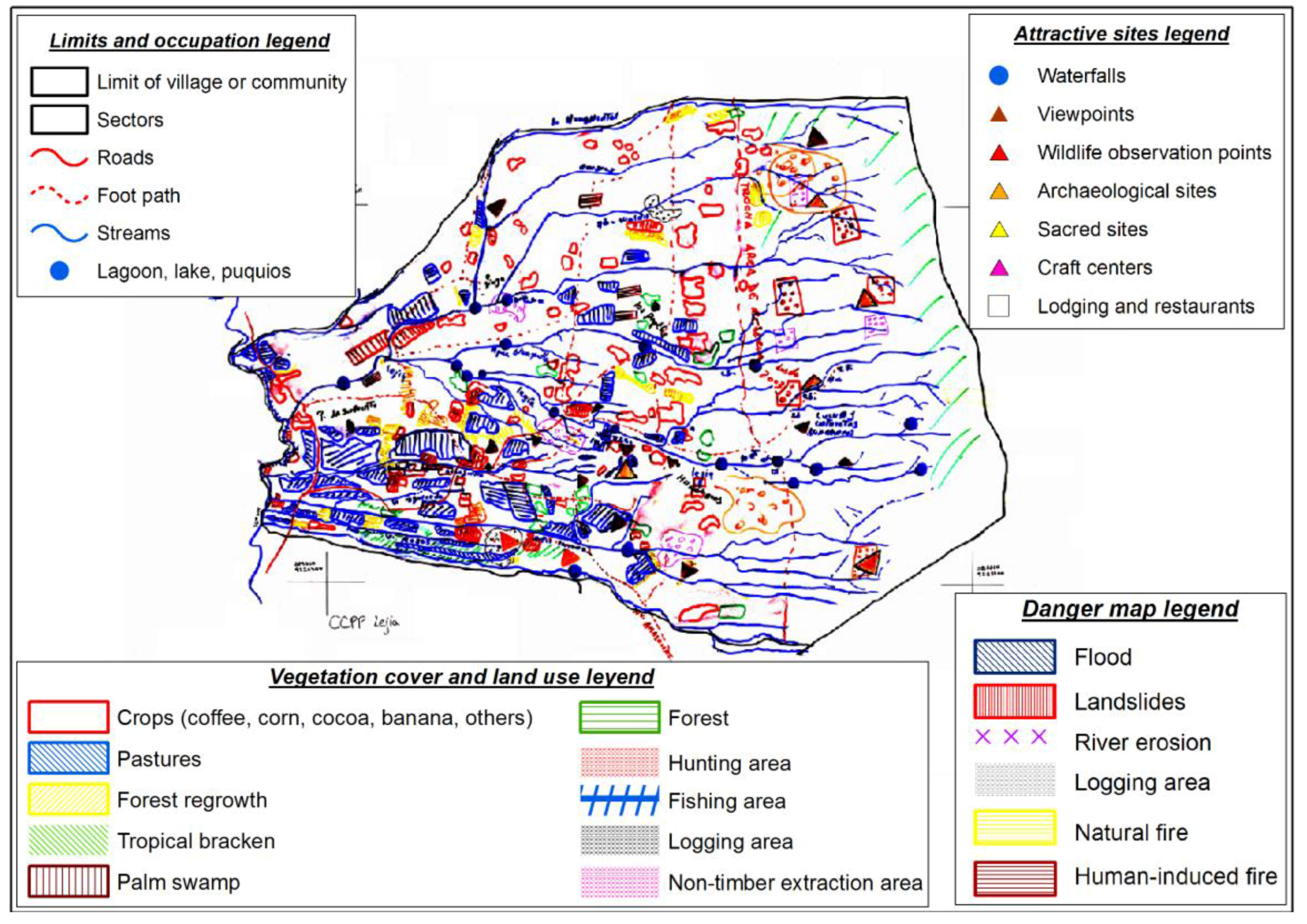
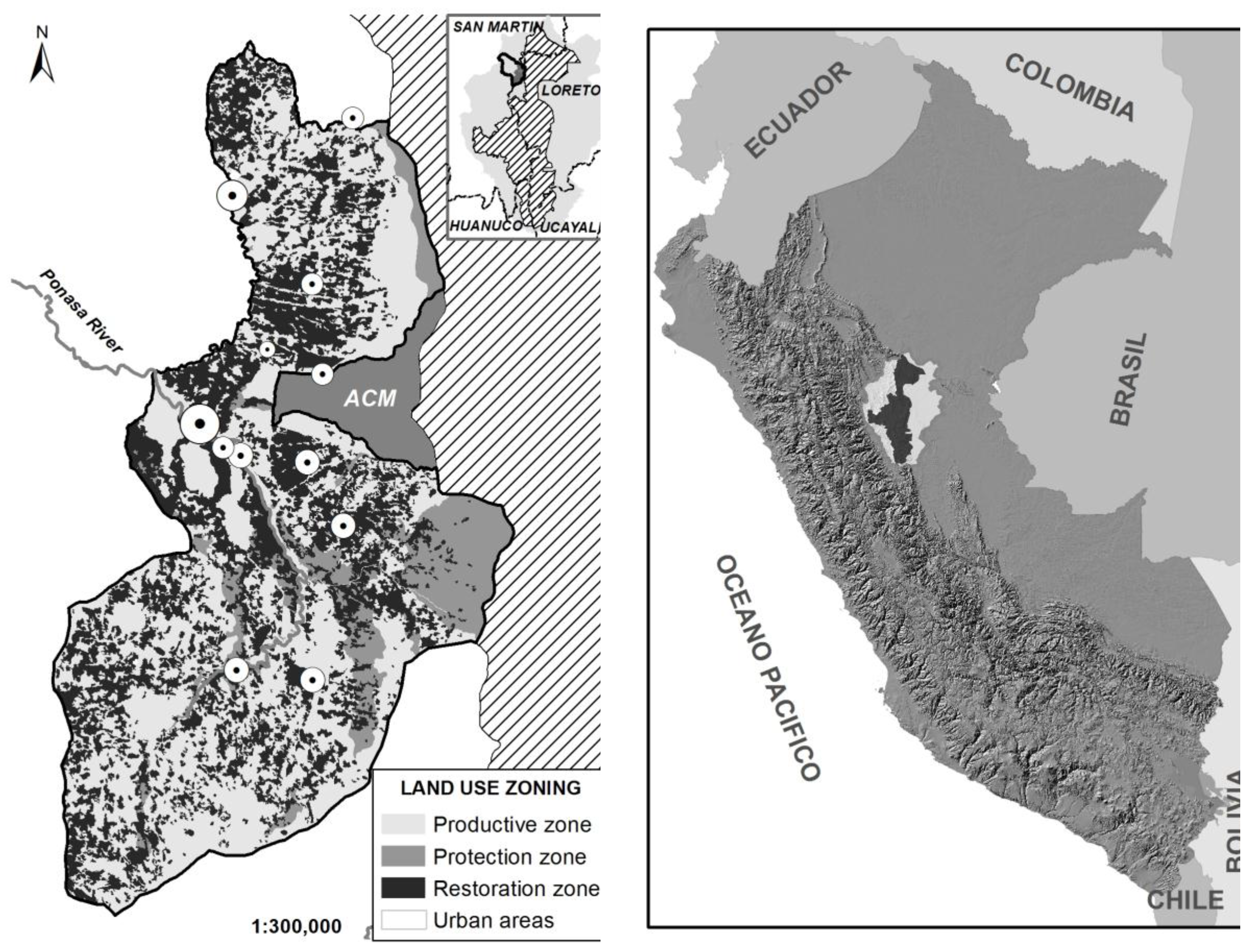
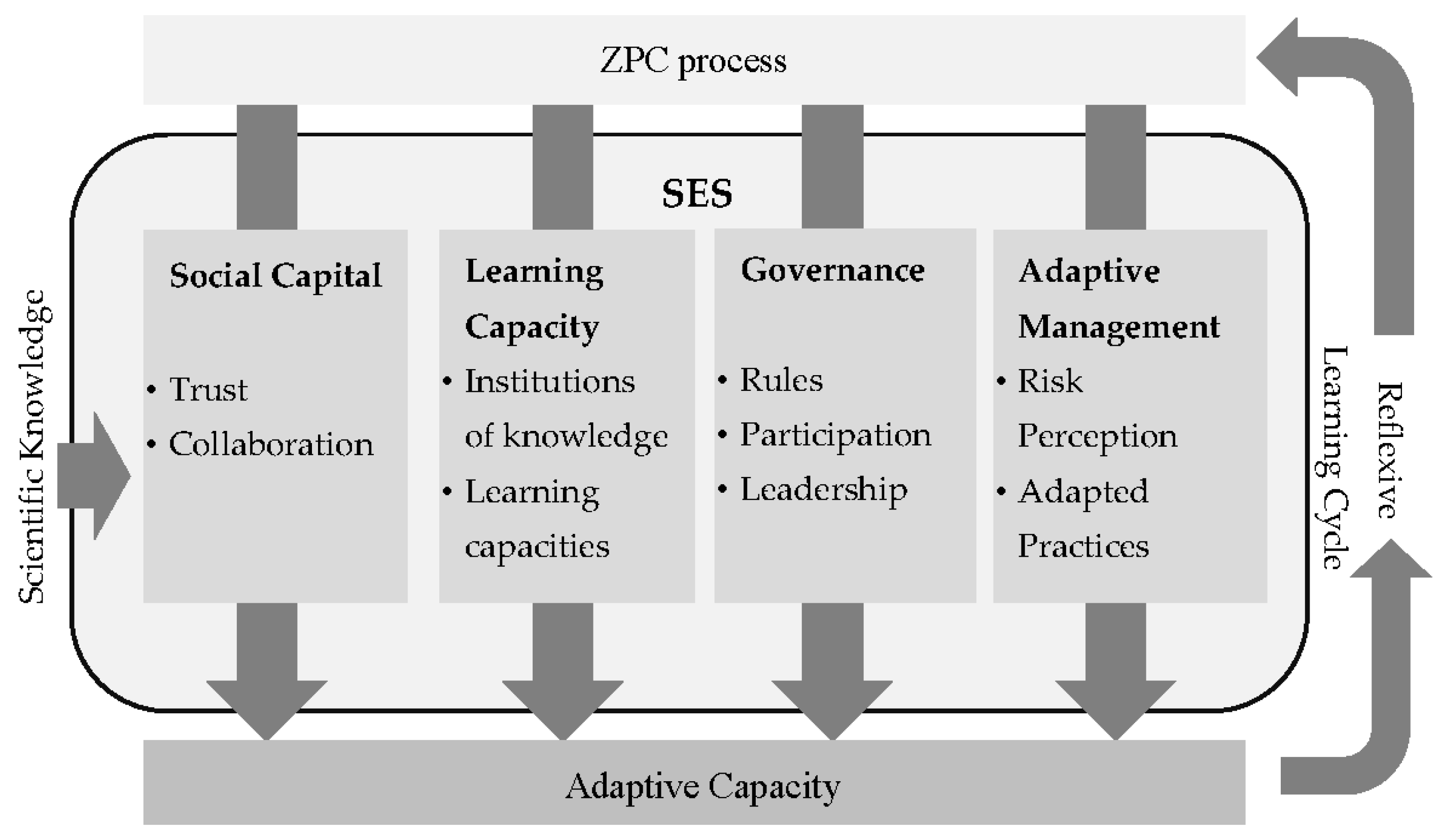
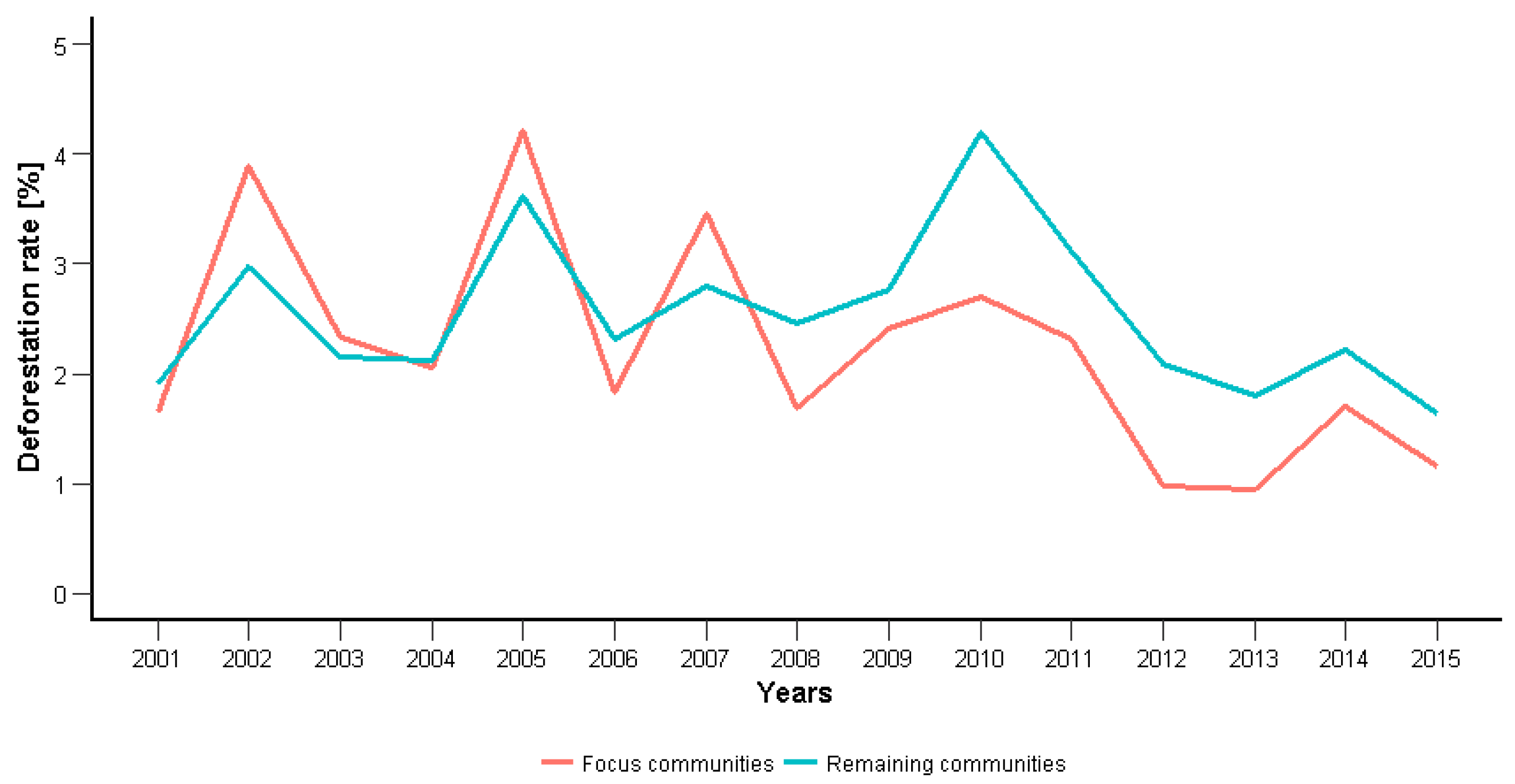
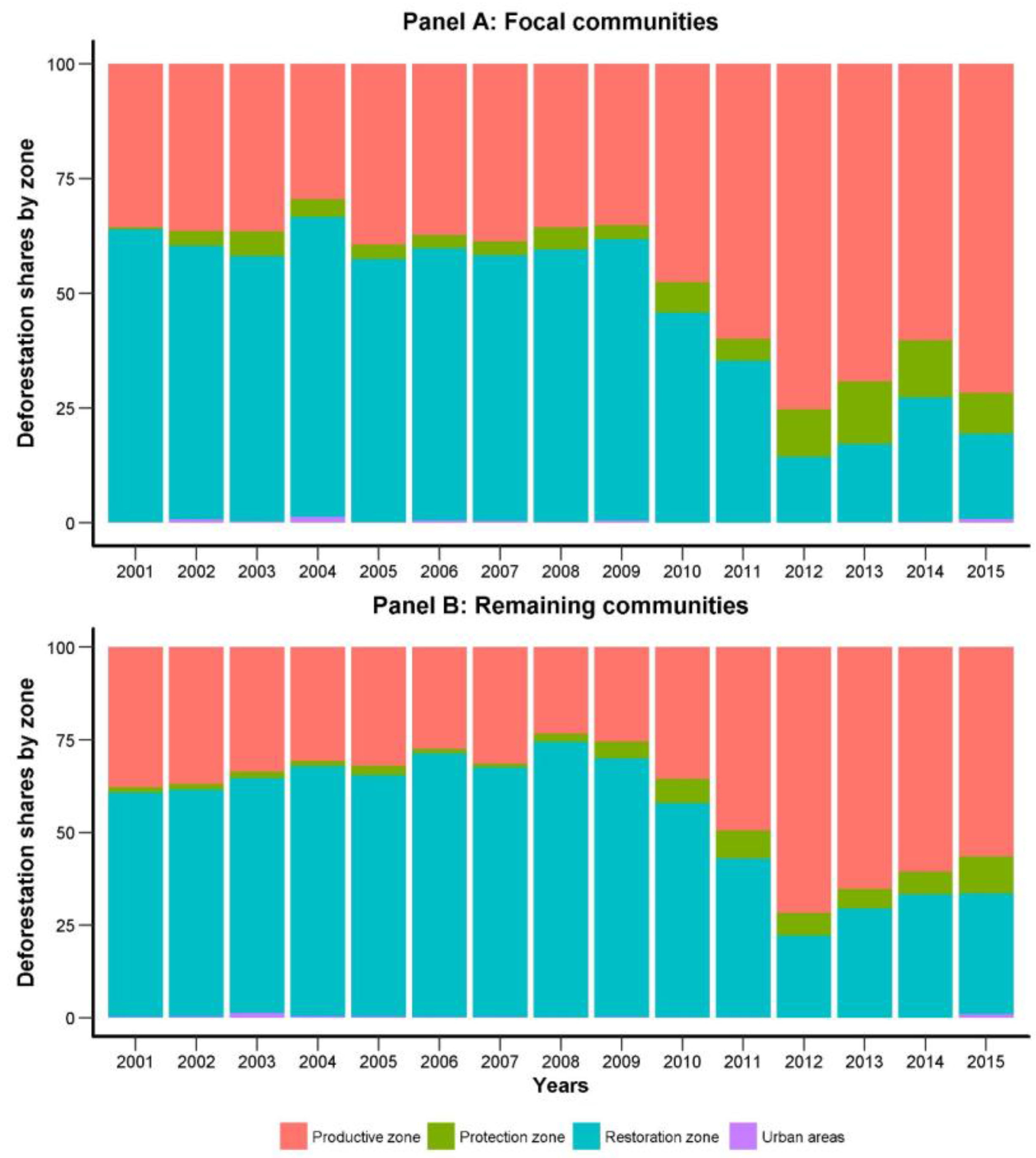
| Duration of ZPC Process | Coexistence Rules (Adoption) | Conservation Projects | Quality of Life Plans (Adoption) | |
|---|---|---|---|---|
| Simon Bolívar | 2006–2011 | Informal | Individual | Informal |
| Chambira | 2006–2011 | Informal | Communal Forest | informal |
| Lejía | 2006–2011 | Formal (2013) | Communal Forest | Formal (2014) |
| Alto Ponaza | 2006–2011 | Formal (2013) | Individual | Formal (2014) |
| Paraíso | 2006–2011 | Formal (2013) | Individual | Formal (2014) |
| Vista Alegre | 2006–2011 | Formal (2013) | Communal Forest and School Forest | Formal (2014) |
| Zone | Urban | Productive | Restoration | Protection | |
|---|---|---|---|---|---|
| Studied Communities | Share of total area [%] | 1.2 | 52 | 38 | 8 |
| Forest cover in 2008 [%] | 6 | 65 | 28 | 84 | |
| Remaining communities in Shamboyacu | Share of total area [%] | 0.4 | 45 | 47 | 7 |
| Forest cover in 2008 [%] | 50 | 70 | 39 | 92 |
© 2018 by the authors. Licensee MDPI, Basel, Switzerland. This article is an open access article distributed under the terms and conditions of the Creative Commons Attribution (CC BY) license (http://creativecommons.org/licenses/by/4.0/).
Share and Cite
Rodríguez, L.O.; Cisneros, E.; Pequeño, T.; Fuentes, M.T.; Zinngrebe, Y. Building Adaptive Capacity in Changing Social-Ecological Systems: Integrating Knowledge in Communal Land-Use Planning in the Peruvian Amazon. Sustainability 2018, 10, 511. https://doi.org/10.3390/su10020511
Rodríguez LO, Cisneros E, Pequeño T, Fuentes MT, Zinngrebe Y. Building Adaptive Capacity in Changing Social-Ecological Systems: Integrating Knowledge in Communal Land-Use Planning in the Peruvian Amazon. Sustainability. 2018; 10(2):511. https://doi.org/10.3390/su10020511
Chicago/Turabian StyleRodríguez, Lily O., Elías Cisneros, Tatiana Pequeño, Maria T. Fuentes, and Yves Zinngrebe. 2018. "Building Adaptive Capacity in Changing Social-Ecological Systems: Integrating Knowledge in Communal Land-Use Planning in the Peruvian Amazon" Sustainability 10, no. 2: 511. https://doi.org/10.3390/su10020511
APA StyleRodríguez, L. O., Cisneros, E., Pequeño, T., Fuentes, M. T., & Zinngrebe, Y. (2018). Building Adaptive Capacity in Changing Social-Ecological Systems: Integrating Knowledge in Communal Land-Use Planning in the Peruvian Amazon. Sustainability, 10(2), 511. https://doi.org/10.3390/su10020511




